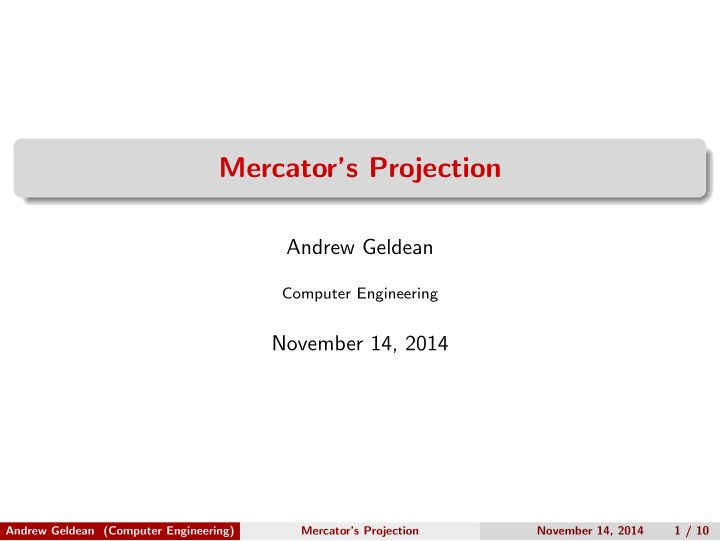



Mercator’s Projection Andrew Geldean Computer Engineering November 14, 2014 Andrew Geldean (Computer Engineering) Mercator’s Projection November 14, 2014 1 / 10
Introduction Cylindrical projection Derivation of equations Truncation and Scale Factor Loxodromes and Geodesics Calculating Distance Figure 1 : Mercator’s Projection Andrew Geldean (Computer Engineering) Mercator’s Projection November 14, 2014 2 / 10
Projecting the Globe Figure 2 : Geometry of a cylindrical projection. Geographic coordinates of latitude φ and longitude λ Tangential to globe at equator Radius of a parallel is Rcos ( φ ) Andrew Geldean (Computer Engineering) Mercator’s Projection November 14, 2014 3 / 10
Small Element Geometry tan α = Rcos ( φ ) δλ and tan β = δ x R δφ δ y Parallel Scale Factor k ( φ ) = P ′ M ′ δ x PM = Rcos ( φ ) δλ Meridian Scale Factor h ( φ ) = P ′ K ′ δ y PK = R δφ Andrew Geldean (Computer Engineering) Mercator’s Projection November 14, 2014 4 / 10
Deriving Mercator’s Projection y ′ ( φ ) tan α , k = sec φ , h = y ′ ( φ ) tan β = Rsec φ R Equality of Angles: α = β − → y ′ ( φ ) = Rsec ( φ ) Equality of Scale Factors: h = k − → y ′ ( φ ) = Rsec ( φ ) Therefore, 4 + φ x = R ( λ − λ 0 ) and y = Rln [ tan ( π 2 )] And inversely, R and φ = 2 tan − 1 [ e ( y R ) ] − π λ = λ 0 + x 2 Andrew Geldean (Computer Engineering) Mercator’s Projection November 14, 2014 5 / 10
Truncation and Scale Factor The ordinate y approaches infinity as the latitude approaches the poles. φ = 2 tan − 1 [ e ( y R ) ] − π 2 = 2 tan − 1 [ e π ] − π 2 = 1 . 48842 radians = 85 . 05133 ◦ Figure 3 : Graph of Scale Factor vs. Latitude. Andrew Geldean (Computer Engineering) Mercator’s Projection November 14, 2014 6 / 10
Loxodromes and Geodesics Loxodromes Paths, also known as rhumb lines, which cut a meridian on a given surface at any constant angle. All straight lines on the Mercator’s Projection are loxodromes. Figure 4 : Loxodromes vs Geodesics Andrew Geldean (Computer Engineering) Mercator’s Projection November 14, 2014 7 / 10
Calculating Distance Representative Fraction The fraction R a is called the representative fraction. It is also known the principal scale of the projection. For example, if a map has an equatorial width of 31.4 cm, then its global 1 radius is 5 cm, which translates to an RF of approximately 130 M . There are two main problems when it comes to calculating distance using Mercator’s projection: Variation of scale with latitude Straight lines on the map do not correspond to great circles Short Distances: True Distance = rhumb distance ∼ = ruler distance × cos φ RF 1 For example, a line of 3mm, its midpoint at 40 ◦ , and an RF of 130 M , the true distance would be approximately 300km Andrew Geldean (Computer Engineering) Mercator’s Projection November 14, 2014 8 / 10
Calculating Distance Measuring longer distances requires different approaches On the equator: True distance = ruler distance RF On other parallels: Parallel distance = ruler distance × cos φ RF On a meridian: m 12 = a | φ 1 − φ 2 | On a rhumb: r 12 = a sec α | φ 1 − φ 2 | = a sec α ∆ φ Andrew Geldean (Computer Engineering) Mercator’s Projection November 14, 2014 9 / 10
Sources http://www.princeton.edu/~achaney/tmve/wiki100k/docs/ Mercator_projection.html http://en.wikipedia.org/wiki/Mercator_projection http: //www.public.asu.edu/~aarios/resourcebank/maps/page10.html http://kartoweb.itc.nl/geometrics/map20projections/body.htm http://www.progonos.com/furuti/MapProj/Normal/CartProp/ ShapePres/shapePres.html Andrew Geldean (Computer Engineering) Mercator’s Projection November 14, 2014 10 / 10
Recommend
More recommend